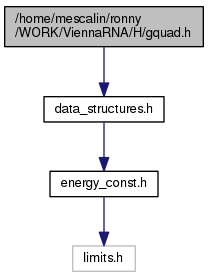Various functions related to G-quadruplex computations. More...
 Include dependency graph for gquad.h:
Include dependency graph for gquad.h:Go to the source code of this file.
Functions | |
| int * | get_gquad_matrix (short *S, paramT *P) |
| Get a triangular matrix prefilled with minimum free energy contributions of G-quadruplexes. More... | |
| int | parse_gquad (const char *struc, int *L, int l[3]) |
| PRIVATE int | backtrack_GQuad_IntLoop (int c, int i, int j, int type, short *S, int *ggg, int *index, int *p, int *q, paramT *P) |
| PRIVATE int | backtrack_GQuad_IntLoop_L (int c, int i, int j, int type, short *S, int **ggg, int maxdist, int *p, int *q, paramT *P) |
Detailed Description
Various functions related to G-quadruplex computations.
Function Documentation
| int* get_gquad_matrix | ( | short * | S, |
| paramT * | P | ||
| ) |
Get a triangular matrix prefilled with minimum free energy contributions of G-quadruplexes.
At each position ij in the matrix, the minimum free energy of any G-quadruplex delimited by i and j is stored. If no G-quadruplex formation is possible, the matrix element is set to INF. Access the elements in the matrix via matrix[indx[j]+i]. To get the integer array indx see get_jindx().
- See Also
- get_jindx(), encode_sequence()
- Parameters
-
S The encoded sequence P A pointer to the data structure containing the precomputed energy contributions
- Returns
- A pointer to the G-quadruplex contribution matrix
| int parse_gquad | ( | const char * | struc, |
| int * | L, | ||
| int | l[3] | ||
| ) |
given a dot-bracket structure (possibly) containing gquads encoded by '+' signs, find first gquad, return end position or 0 if none found Upon return L and l[] contain the number of stacked layers, as well as the lengths of the linker regions. To parse a string with many gquads, call parse_gquad repeatedly e.g. end1 = parse_gquad(struc, &L, l); ... ; end2 = parse_gquad(struc+end1, &L, l); end2+=end1; ... ; end3 = parse_gquad(struc+end2, &L, l); end3+=end2; ... ;
| PRIVATE int backtrack_GQuad_IntLoop | ( | int | c, |
| int | i, | ||
| int | j, | ||
| int | type, | ||
| short * | S, | ||
| int * | ggg, | ||
| int * | index, | ||
| int * | p, | ||
| int * | q, | ||
| paramT * | P | ||
| ) |
backtrack an interior loop like enclosed g-quadruplex with closing pair (i,j)
- Parameters
-
c The total contribution the loop should resemble i position i of enclosing pair j position j of enclosing pair type base pair type of enclosing pair (must be reverse type) S integer encoded sequence ggg triangular matrix containing g-quadruplex contributions index the index for accessing the triangular matrix p here the 5' position of the gquad is stored q here the 3' position of the gquad is stored P the datastructure containing the precalculated contibutions
- Returns
- 1 on success, 0 if no gquad found
| PRIVATE int backtrack_GQuad_IntLoop_L | ( | int | c, |
| int | i, | ||
| int | j, | ||
| int | type, | ||
| short * | S, | ||
| int ** | ggg, | ||
| int | maxdist, | ||
| int * | p, | ||
| int * | q, | ||
| paramT * | P | ||
| ) |
backtrack an interior loop like enclosed g-quadruplex with closing pair (i,j) with underlying Lfold matrix
- Parameters
-
c The total contribution the loop should resemble i position i of enclosing pair j position j of enclosing pair type base pair type of enclosing pair (must be reverse type) S integer encoded sequence ggg triangular matrix containing g-quadruplex contributions p here the 5' position of the gquad is stored q here the 3' position of the gquad is stored P the datastructure containing the precalculated contibutions
- Returns
- 1 on success, 0 if no gquad found

